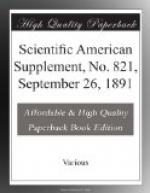[Footnote 3: Transactions Northeast Coast Institution of Engineers and Shipbuilders, vol. 6, 1889-90, p. 253.]
Economy of Fuel.—Coming to the highly important question of economy of fuel, the average consumption of coal per indicated horse-power is 1.522 lb. per hour. The average working pressure is 158.5 lb. per square inch. Comparing this working pressure with 77.4 lb. in 1881, a superior economy of 19 per cent. might be expected now, on account of the higher pressure, or taking the 1.828 lb. of coal per hour per indicated horse-power in 1881, the present performance under similar conditions should be 1.48 lb. per hour per indicated horse-power. It appears that the working pressures have been increased twice in the last ten years, and nearly three times in the last nineteen. The coal consumptions have been reduced 16.7 per cent. in the last ten years and 27.9 per cent. in the last nineteen. The revolutions per minute have increased in the ratios of 100, 105, 114; and the piston speeds as 100, 124, 140. Although it is quite possible that the further investigations of the Research Committee on Marine Engine Trials may show that the present actual consumption of coal per indicated horse-power is understated, yet it is hardly probable that the relative results will be affected thereby.
Dimensions.—In the matter of the power put into individual vessels, considerable strides have been made. In 1881, probably the greatest power which has been put into one vessel was in the case of the Arizona, whose machinery indicated about 6,360 horse-power. The following table gives an idea of the dimensions and power of the larger machinery in the later passenger vessels:
TABLE III.—DIMENSIONS AND POWER OF MACHINERY IN LATER PASSENGER VESSELS.
-----+----------------+-----------------------+-------+
-----------+ | | |Length | | Year.| Name of vessel.| Diameters of | of |Indicated | | | cylinders. |Stroke.|horsepower.| -----+----------------+-----------------------+-------+-----
------+ | | Inches. |Inches.| | 1881 |Alaska | 68, 100, 100 | 72 | 10,686 | -----+----------------+-----------------------+-------+-----
------+ 1881 |City of Rome | 46, 86; 46, 86; 46, 86| 72 | 11,800 |




